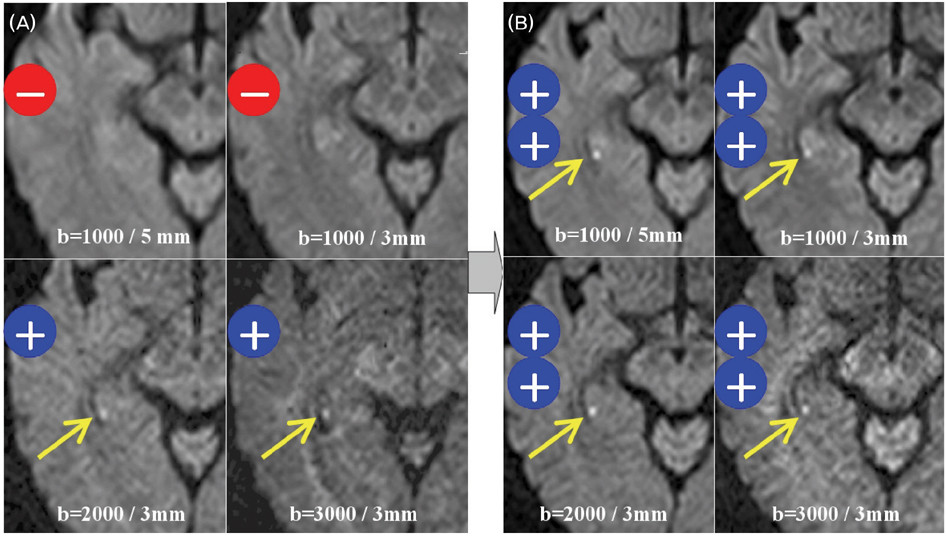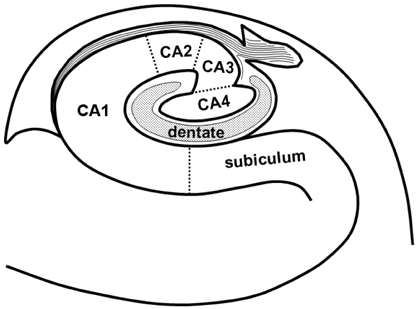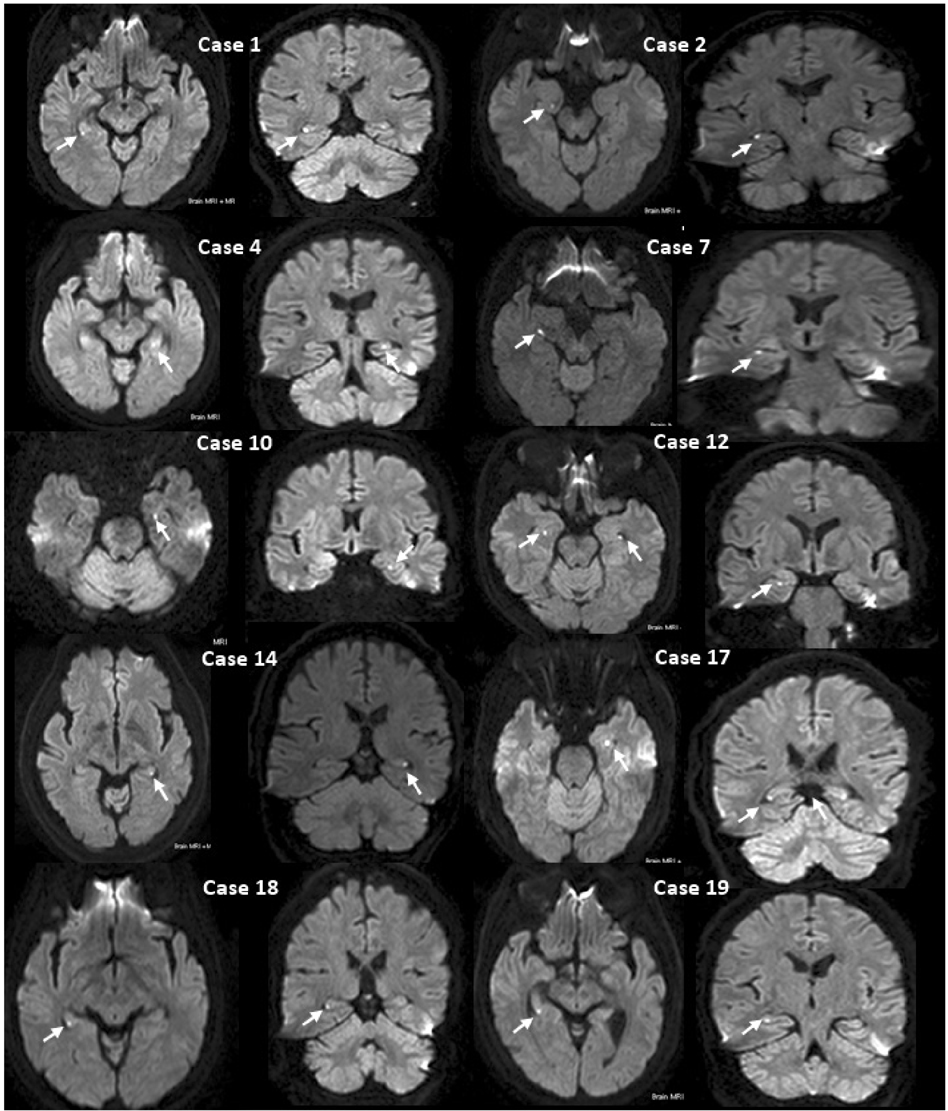J Clin Neurol.
2008 Jun;4(2):59-66. 10.3988/jcn.2008.4.2.59.
Ischemic Evidence of Transient Global Amnesia: Location of the Lesion in the Hippocampus
- Affiliations
-
- 1Department of Neurology, Soonchunhyang University College of Medicine, Seoul, Korea.
- 2Department of Neurology, Seoul National University College of Medicine, Seoul, Korea. neuroksy@snu.ac.kr
- 3Department of Radiology, Seoul National University College of Medicine, Seoul, Korea.
- KMID: 2178924
- DOI: http://doi.org/10.3988/jcn.2008.4.2.59
Abstract
- Background and purpose
Transient global amnesia (TGA) is a rare amnestic syndrome characterized by the sudden onset of a selective anterograde and retrograde amnesia with a time course of up to 24 hours. Recent studies have found a high frequency of small high-signal abnormalities in the hippocampus on diffusion-weighted imaging (DWI), and accordingly ischemia has been proposed as an etiology of TGA. We hypothesized that TGA lesions occur preferentially in the CA1 region of the hippocampus, which is known to be susceptible to ischemia. Methods: Twenty consecutive patients with a clinical diagnosis of TGA underwent DWI both within 24 hours of symptom onset and 3 days later. Twenty patients with high-signal abnormalities in the hippocampus on the initial DWI underwent subsequent DWI and T2-weighted imaging in the coronal plane to precisely localize the lesions. Results: Seventeen patients had small high-signal abnormalities (with diameters of 1-3 mm) in the hippocampus unilaterally on DWI. One of these patients had two lesions in one hippocampus. Three of the 20 patients had lesions bilaterally in the hippocampus, 1 of whom had 3 bilateral lesions. A total of 25 lesions were identified: 5 in the hippocampal head, 19 in the body, and 1 in the tail. Six patients had unilateral lesions on the left,11 patients had them on the right, and 3 patients had bilateral lesions. Conclusions: In this study, lesions associated with TGA were localized mostly to the lateral portion of the hippocampus, corresponding to CA1. This finding supports the ischemic etiology of TGA, but the underlying pathophysiologic mechanism requires further investigation.
Keyword
Figure
Cited by 2 articles
-
Cerebellar Hypoperfusion during Transient Global Amnesia: An MRI and Oculographic Study
YoungSoon Yang, Ji Soo Kim, SangYun Kim, Yu Kyeong Kim, Yong Tae Kwak, Il-Woo Han
J Clin Neurol. 2009;5(2):74-80. doi: 10.3988/jcn.2009.5.2.74.Transient Global Amnesia Caused by Bilateral Medial Temporal-Lobe Infarction
UnKyu Yun, Inha Hwang, Sang-Won Ha
Dement Neurocogn Disord. 2017;16(4):132-133. doi: 10.12779/dnd.2017.16.4.132.
Reference
-
1. Hodges JR, Warlow CP. Syndromes of transient amnesia: towards a classification. A study of 153 cases. J Neurol Neurosurg Psychiatry. 1990. 53:834–843.
Article2. Hodges JR, Warlow CP. The aetiology of transient global amnesia. A case-control study of 114 cases with prospective follow-up. Brain. 1990. 113:639–657.3. Pantoni L, Lamassa M, Inzitari D. Transient global amnesia: a review emphasizing pathogenic aspects. Acta Neurol Scand. 2000. 102:275–283.
Article4. Matsuda H, Higashi S, Tsuji S, Sumiya H, Miyauchi T, Hisada K, et al. High resolution Tc-9m HMPAO SPECT in a patient with transient global amnesia. Clin Nucl Med. 1993. 18:46–49.
Article5. Stillhard G, Landis T, Schiess R, Regard M, Sialer G. Bitemporal hypoperfusion in transient global amnesia: 99m-Tc-HM-PAO SPECT and neuropsychological findings during and after an attack. J Neurol Neurosurg Psychiatry. 1993. 53:339–342.
Article6. Warren JD, Chatterton B, Thompson PD. A SPECT study of the anatomy of transient global amnesia. J Clin Neurosci. 2000. 7:57–59.
Article7. Jovin TG, Vitti RA, McCluskey LF. Evolution of temporal lobe hypoperfusion in transient global amnesia: a serial single photon emission computed tomography study. J Neuroimaging. 2000. 10:238–241.
Article8. Strupp M, Bruning R, Wu RH, Deimling M, Reiser M, Brandt T. Diffusion-weighted MRI in transient global amnesia: elevated signal intensity in the left mesial temporal lobe in 7 of 10 patients. Ann Neurol. 1998. 43:164–170.
Article9. Sedlaczek O, Hirsch JG, Grips E, Peters CN, Gass A, Wohrle J. Detection of delayed focal MR changes in the lateral hippocampus in transient global amnesia. Neurology. 2004. 62:2165–2170.
Article10. Heiman M. Über Gefässtudien am aufgehellten Gehirn I. Die Gefässe des Ammonshornes. Arch Neurol Neurochir Psychiatr. 1937. 40:277–302.11. Duvernoy HM. The human hippocampus: an atlas of applied anatomy. 1988. Munich: JF Bergmann;1–60.12. Lewis SL. Aetiology of transient global amnesia. Lancet. 1998. 352:397–399.
Article13. Akkawi NM, Agosti C, Rozzini L, Anzola GP, Padovani A. Transient global amnesia and disturbance of venous flow patterns. Lancet. 2001. 357:957.
Article14. Maalikjy Akkawi N, Agosti C, Anzola GP, Borroni B, Magoni M, Pezzini A. Transient global amnesia: a clinical and sonographic study. Eur Neurol. 2003. 49:67–71.
Article15. Pantoni L, Lamassa M, Inzitari D. Transient global amnesia: a review emphasizing pathogenic aspects. Acta Neurol Scand. 2000. 102:275–283.
Article16. Zorzon M, Antonutti L, Masè G, Biasutti E, Vitrani B, Cazzato G. Transient global amnesia and transient ischemic attack. Natural history, vascular risk factors, and associated conditions. Stroke. 1995. 26:1536–1542.
Article17. Winbeck K, Etgen T, von Einsiedel HG, Röttinger M, Sander D. DWI in transient global amnesia and TIA: proposal for an ischaemic origin of TGA. J Neurol Neurosurg Psychiatry. 2005. 76:438–441.
Article
- Full Text Links
- Actions
-
Cited
- CITED
-
- Close
- Share
- Similar articles
-
- Retrograde Amnesia as a Predominant Symptom of Transient Global Amnesia
- Confusing Transient Epileptic Amnesia versus Transient Global Amnesia: Unraveling the Diagnostic and Therapeutic Challenges
- Transient global amnesia associated with multiple lesions in the corpus callosum and hippocampus
- Transient Global Amnesia Developed in a 14-Year Old Girl during Cellular Phone Texting
- Insular Infarction Presenting With Transient Global Amnesia





